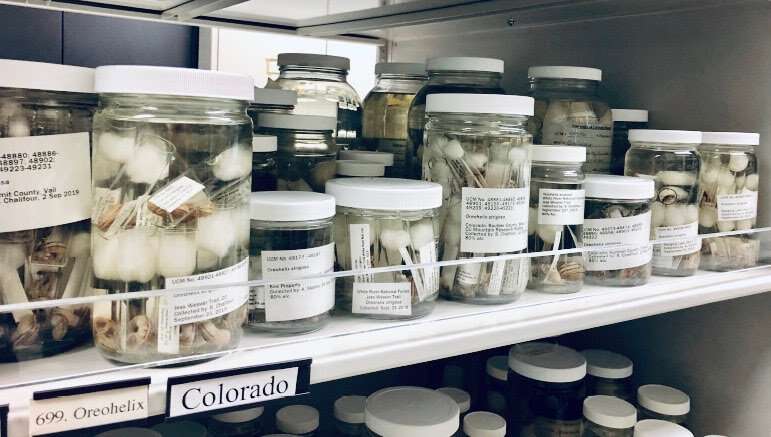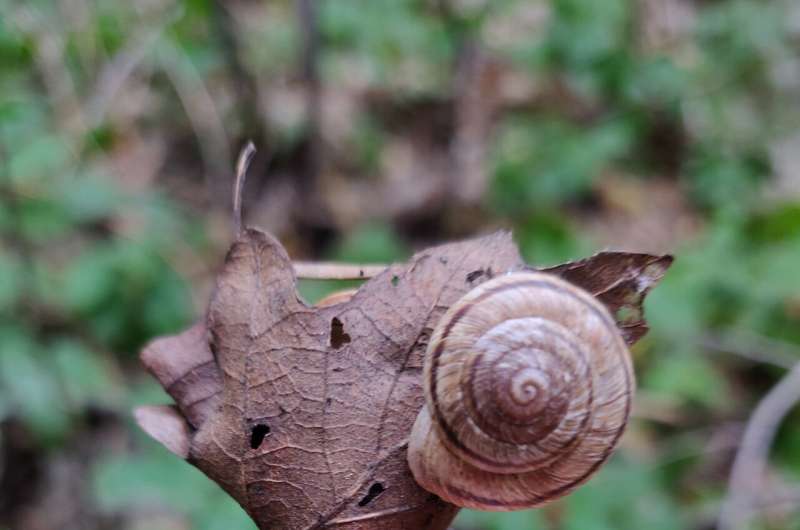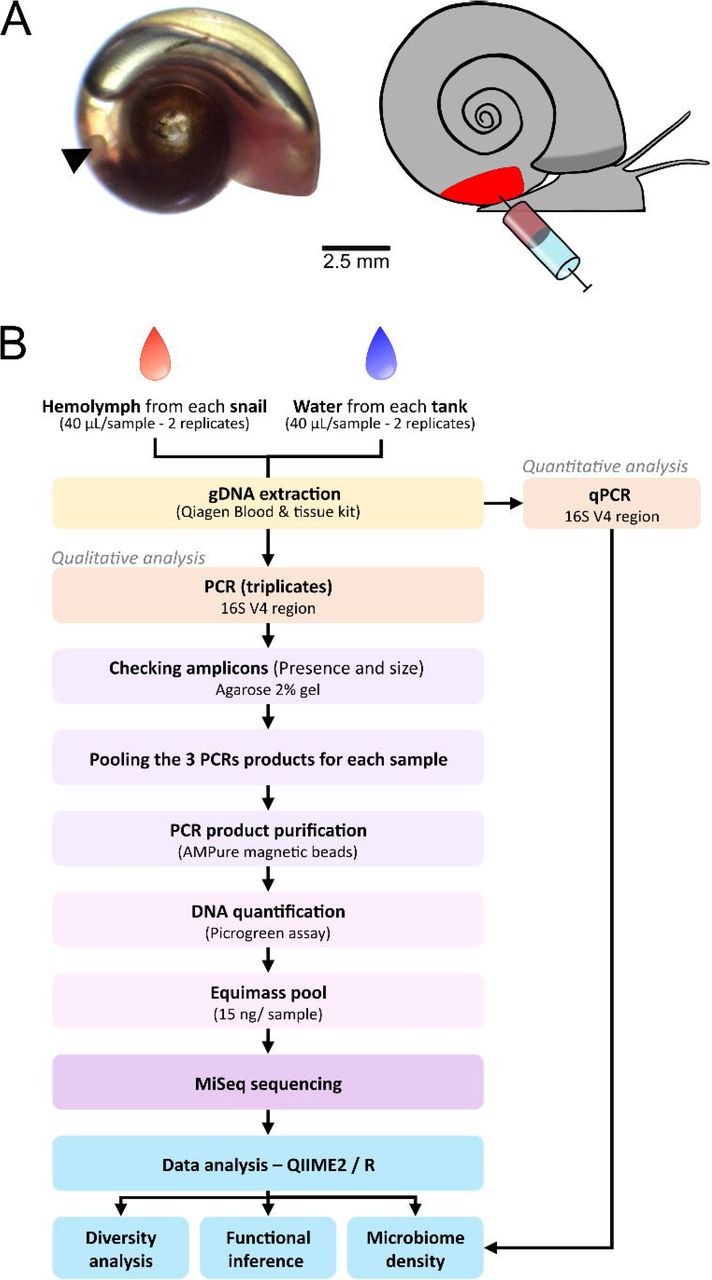On a drizzly day in July 1920, a Colorado scientist named Junius Henderson was hiking around the Dakota Hogback, a sandstone ridge north of Boulder. There, he spotted a group of Rocky Mountain snails (Oreohelix strigosa) oozing across the ground. Henderson scooped up the mollusks and brought them back to his lab at what is now called the University of Colorado Museum of Natural History, carefully preserving his finds.
Now, a century later, a team of ecologists from the CU museum have returned to those snails, obtaining surprising insights into something that Henderson couldn’t have predicted at the time: the diverse communities of bacteria and other microbes, known collectively as the microbiome, that flourished inside the mollusks’ guts.
For the first time ever, researchers have used modern, DNA-screening tools to identify the microbes that once lived in the guts of animals that have been dead for a century. Bridget Chalifour, who led the study, said the findings show just how valuable museum collections can be—microbiomes could offer an unexpected window into how animals interacted with their environments as far back as the era of Prohibition, or even farther.
“We’ve learned that samples from 50 or 100 years ago have just as much viability to answer modern, ecological questions as samples collected just two years ago,” said Chalifour, who recently earned her doctorate in ecology and evolutionary biology from CU Boulder.
She and her colleagues published their results June 29 in the journal Microbiome.
The results come as scientists are realizing how important gut microbiomes are for many animals and even humans. Recent research from CU Boulder, for example, has shown that a healthy population of intestinal bacteria can help people fight stress or even sleep better.
The new approach doesn’t have to stop at snails: Scientists could use a similar method to scan the microbiomes of a range of other animals that museums often store in ethanol, including many spiders, frogs and snakes.
“This work opens the door to unlimited possibilities,” said study co-author Jingchun Li, curator of invertebrates at the museum and assistant professor of ecology and evolutionary biology. “It means that millions of museum specimens accumulated through centuries worldwide can be used for microbiome research.”

Rocky Mountain snails preserved in ethanol sit on a shelf at the CU Museum of Natural History. © Bridget Chalifour
Keep an eye out
You may never have seen a Rocky Mountain snail, even if you’ve lived and hiked in Colorado for years. These animals, which are about the size of your thumbnail, munch on leaves and other plant matter at sites from Canada south into New Mexico.
But they tend to only come out when it’s wet.
“When it’s raining, they’re usually out grazing on rocks or trees at places like Eldorado Canyon in Boulder,” Chalifour said.
Over the years, Boulder researchers have collected roughly 1,000 of these snails, storing them, like Henderson’s early finds, in ethanol.
“Museum specimens and artifacts are the next best thing to a time machine,” Li said. “With many such specimens and data, we can ask how the changing climate has shaped mountain plant communities through time. We can detect what organisms survived mass extinction events.”
Li and Chalifour, plus a former collections manager at CU Boulder named Leanne Elder, decided to take a special peek at the snails’ innards.
Lost populations
The team gathered a collection of 55 Rocky Mountain snails plucked up between 1920 and 2018 from a region stretching from Boulder in the east to Telluride in the southwest. They included three snails that Henderson, whose name now adorns the museum’s main building on campus, had found. The researchers then emptied the mollusks. The microorganisms within their guts had also been dead for decades, but the team was able to sequence what was left of their DNA.

Microbes in the guts of Rocky Mountain snails may help the animals digest leaves and other plant matter. © Bridget Chalifour
The gutsy approach paid off:
When they died decades ago, the mollusks had been bursting with life. The researchers identified evidence of more than 7,000 organisms, mostly bacteria, hiding inside each snail.
Ethanol didn’t seem to degrade their DNA either: The team found equally diverse microbiomes in Henderson’s century-old samples as in snails that Chalifour had collected herself and never stored in a jar.
“It’s exciting for me because I’ve now deposited a lot of samples into the museum,” Chalifour said. “I like to think about what people may do with my snails in 15 years.”
She noted that the microbiomes of the snail specimens shifted a bit over the century for reasons that aren’t clear. Henderson’s mollusks, for example, harbored a lot of bacteria belonging to the genera Bradyrhizobium, Alicycliphilus and Cloacibacterium. Snails collected in 2018, meanwhile, were partial to Flavobacterium and the families Chitinophagaceae and Cerasicoccaceae. Where the animals live, however, mattered a lot more, accounting for about 20% of the microbial variation between snails.
Those microorganisms, Chalifour said, likely helped the snails eke out a living in the Rockies: Many of the bacteria the team found belonged to groups that are often able to break down complex organic molecules—like the cellulose in the leaves that snails eat.
Today, droughts and wildfires may be squeezing these wet-weather animals out of their former habitats, Chalifour added.
She spent days looking for snails around Boulder County where Henderson collected his original specimens. She couldn’t find any.
“A lot of the populations we have in our collections aren’t there anymore,” Chalifour said.
More information:
Bridget N. Chalifour et al, Gut microbiome of century-old snail specimens stable across time in preservation, Microbiome (2022). DOI: 10.1186/s40168-022-01286-z
Provided by
University of Colorado at Boulder
Citation:
Researchers identify the microbes in 100-year-old snail guts (2022, June 29)



